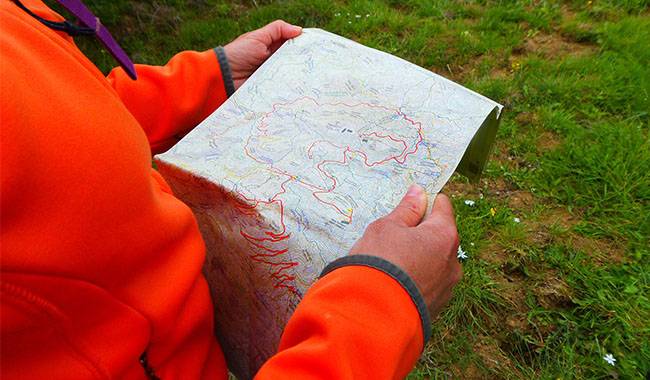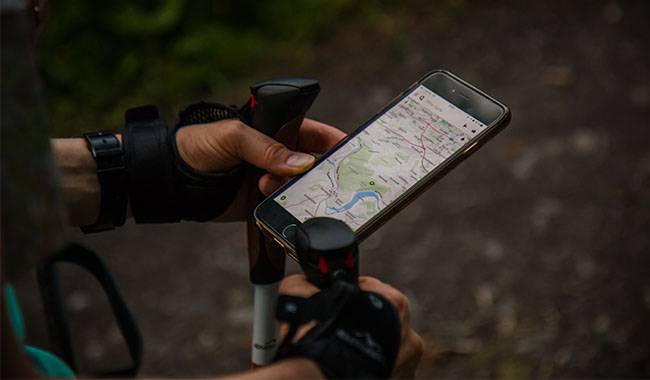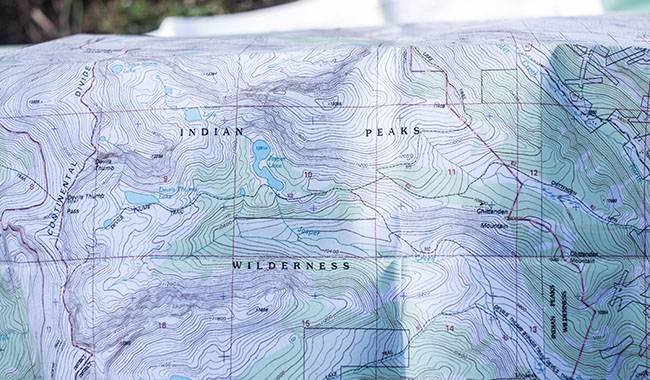
The key to safe travel is adequate preparation. The better the route is planned, the greater the likelihood of success. A mistake or unfortunate accident on an easy stretch of road will force you to cut your route short and wait for help. Having a clear view of the route ahead can help avoid this situation. In this LCN Outdoors article, you will learn how to use topographic maps, how to plan your route, and what to consider when preparing for a hiking trip.
How to Use the Navigation on a Hiking Trip
Good orienteering skills can help you determine your location and enable you to plan the best route. A distinction can be made between the two most popular methods of orienteering and therefore route planning.
A. By paper map and compass
The classic way. The advantage of this method is that with some care, the laminated map and compass will last a long time and help you in extreme situations. It requires concentration and thoughtful work on the map and therefore develops a good “spatial sense”. Learning to navigate with a map and compass requires regular practice.
B. By using electronic devices with satellite signals, such as GPS or GLONASS
A modern method that allows you to quickly determine your position and easily check it against a pre-installed track. It’s convenient because it gives quick and mostly accurate answers. But it’s also tricky: if you don’t know your area, you may develop “4P syndrome” – “constantly checking tracks” – where you don’t analyze the terrain, but just relate your location to the track you’re on. It’s also worth considering the drawbacks of electronics: limited run time and the possibility of errors due to satellite signal interference.
It’s best to start practicing planning and orienteering skills on routes you already know or have completed. In this way, you can get rid of the fear of getting lost and gain or improve your map and compass skills. Here’s what to do.
- Draw the track of the upcoming path at home.
- Calculate the mileage and time. Use a map service to print maps.
- Use a paper map to follow the route.
You can get practice by participating in races with an orienteering element: wheelbarrow races, marching races, or multiple races. They offer ideal conditions for practicing shortest route planning and orienteering skills, with courses of different difficulty levels and separate categories for beginners. A pleasant bonus – you are left with a detailed map of the area, which you can traverse more than once. The main thing is to compact it with transparent tape or carry it in a Ziploc bag.
Tip: Ants navigate by smell, migratory birds by the sun and stars, cats and bats by magnetic fields, dolphins by low-frequency sound waves, and dung beetles by the Milky Way.
If you can’t get to the woods or the nearest park and the race isn’t in the near future, try practicing on your computer or phone. Here are some services and apps to help you train your memory, map skills, and quick decision-making.
Ski-O Map Memory;
The Forest;
Virtual O;
Tempo Game;
O-Puzzle;
O Sudoku;
Maps World of O.
Ideal conditions for improving orienteering skills in marching races, roller derby, or multiplayer competitions.
Tour Route Planning Stage

A step-by-step approach is at the heart of successful planning. Through a step-by-step approach, an understanding of the entire course, its special features, and areas that require special attention is gained. And in this process, every point is important. Neglecting even one of them can lead to gaps in your understanding of the goals and specifics of the journey. And that can lead to stressful or life-threatening situations. That’s why it’s important to figure out how to tackle even the seemingly simplest of routes.
A clear understanding of the track ahead is often underestimated. And there’s a reason for that. It’s important to know exactly how much time you have at your disposal and how far you have to travel. Errors in calculating time and distance are sung in many reports, for example in the form of “darkness suddenly falling”. Naturally, there is no suddenness in this. Darkness falls in due course, the temperature predictably drops, visibility decreases, and fatigue gradually increases. That’s how things work, not the other way around. Often, the wrong time is to overestimate your strength and underestimate the complexity of the route. The distance traveled turns out to be less than planned, resulting in an overnight stay in an unprepared place.
A. We study the terrain and calculate the distance
Once you have chosen your destination, study the topographical map of the area to be traversed. It is important to have a topographic map, not a hiking map, as it is not detailed enough. A topographic map contains detailed information about the terrain, trails, woodlands, water bodies, and other visually identifiable landmarks. Topographic maps contain distance information, which is “coded” to scale, and elevation differences. With a topographic map and compass, you can navigate accurately.
In the mountains, it is important to pay attention to the big elements of the terrain: ridges, valleys, rivers, and passes. When planning a hiking route, both horizontal and vertical meters must be considered. Each horizontal centimeter is 820 feet (250 meters) on the ground on a 1:25,000 scale map, and 1,640 feet (500 meters) on a 1:50,000 scale.
Topographic maps use contour lines – closed curves where all points are at the same height above sea level – to determine elevation differences. These lines give an indication of the topography. When the horizontal lines are close together, the slope is steep, while when the horizontal lines are farther apart, the slope is flatter.
The general principle of this trail is to choose the path with the least elevation gain or loss. There are usually exceptions when visiting places of special significance or for training purposes.
You can determine the distance on a paper map by using a curved ruler. This instrument consists of a toothed roller and a counter to count the number of teeth walked. To find the length, you need to roll the roller along a line on the map. The dial or display will show the length in centimeters. If you know the scale of the map, you can easily calculate the distance.
B. Determining the complexity of the route
You should first figure out if the trails on the route are easy, moderately difficult, or difficult. These are indicated on the map with different dotted lines. The difficulty of a trail is determined by both its coverage and its “readability”. You should keep in mind that trails may appear in places that are not marked on the map, or they may not appear where they are marked. It may be easier to follow an azimuth, which is a straight line than to find a trail that keeps disappearing.
During the planning phase, it is also important to identify technically difficult places: switchbacks, steep climbs and descents, boulders, dense forests, snowfields, and glaciers. It is recommended that you study hiker reports and photos of the area where you plan your route. You should keep in mind how much the difficulty of the same trail can vary in different weather conditions. Snow-covered boulders, as well as thawing rock walls, can be serious obstacles on the trail, forcing you to turn around or find detours.
C. We assess our ability
It is important to critically assess your strength and fitness level and to take into account possible delays rather than acceleration when calculating your schedule. This will help avoid wasting energy early and maintain a comfortable pace. On group hikes, the experience and fitness of each participant should be taken into account, and everyone should be informed in advance where the route is, how long it will take, and what the load will be.
These times are based on an average speed of 2.5 miles (4 km) per hour on flat ground, 990 feet (300 m) per hour uphill, and 1,640 feet (500 m) per hour downhill. The physical condition of the competitors must be taken into account and adjusted for weather and road conditions. Ice, snow, mud, grass, and technically difficult sections without trails are all factors that slow down the pace.
Don’t forget to schedule breaks and sightseeing. On average, this is 5-10 minutes of rest time per hour or 10-20% of the time on the trail. In sport hiking, rest time is calculated separately.
D. Calculate the travel time
By calculating distance, elevation gain and loss, time to cover difficult sections, as well as stops and possible force majeure, you will get an approximate time to guide you in planning your route.
Tip: Don’t just include external factors or dry counts in your time calculations, but also include the weight of your pack. It affects your speed, so it’s important to reduce the load as much as possible while maintaining an acceptable level of comfort and safety. Read how to do this in the article “How to lighten your gear so you don’t get bored with backpacking”.
E. We mark water sources
You should pay special attention to places where you can refill your water in advance and try to find information about the quality of these springs. Practice shows that many of the springs marked on the map may be seasonal. Water is available only in spring and early summer, during periods of active snowmelt. Water from unreliable springs, such as ponds, may have to be filtered, and wells may not be equipped to take water from deep water, requiring ropes and ingenuity to reach the life-giving water.
It is also important to determine the distance between water sources and to calculate the amount of water used for work and for backup. Lack of timely hydration can greatly reduce speed and increase the time spent on the route. Don’t overlook the stores and cafes along the route where water can be purchased. Lightweight travel filters can quickly purify water from unreliable sources.
F. Planning places to stay
Often, good overnight sites are marked on a map. These are large, flat sites with no rockfall, avalanche risk, or flooding. Be aware that conditions can change, so reassess the safety of the site on the spot, regardless of the popularity of the campsite.
Shelters, barns, and other man-made refuges for overnight stays or shelter from the weather are also worth paying attention to when planning your route. Choose the right place to spend the night so you don’t wake up in the water, under an avalanche, or on a wildlife trail.
G. We consider safety measures and evacuation plans
When planning, you need to consider alternatives to bypass difficult terrain and ways to get to civilization. The weather in the mountains can change very quickly, so you should have the coordinates of all possible shelters. These shelters can range from special hiking trip shelters or shepherd’s dwellings to natural shelters.
In mountainous areas, there is often no cell phone service. In such cases, a satellite phone or satellite tracker that shows the traveler’s location in real-time can help. Some trackers have text messaging capabilities.
If there is a potentially dangerous route, it must be registered with the U.S. Department of Emergency Services or the appropriate local service abroad. It should be understood that the more inaccessible an area is, the longer it will take for rescuers to get there. Helicopters are rare and takeoff times depend on the weather, so chances are rescuers will have to walk to you, which takes time. If you evacuate a casualty, the return trip will take several times longer.
Consider also that if you leave the trail, you will need money to pay for transportation services. This should be budgeted for in the budget for the hike.
H. We analyze experiences and work on mistakes
Planning doesn’t stop at the map stage. To avoid mistakes in the future, after returning from the hiking trip you should analyze the information obtained: whether the real data match the planned ones, where you spent more time than you expected, and what difficulties you encountered along the way. Answering these questions will help you to plan your next hiking trip correctly.
Useful Services for Planning Routes

During the route research phase, it is convenient to use the e-services, which quickly display the different track options, and the maximum number of combinations and help you choose the most convenient track. Save and download the generated version of the tracks to your watch, navigator or smartphone. They will support you when working with paper maps. Of course, you can also use tracks as your primary means of navigation, but in this case, the learning effect and immersion will be significantly reduced.
A. Services for route construction and analysis
Nakarte.me is a map aggregator and probably the best service for planning new routes. As the developers themselves say, it is a website created by visitors for visitors. Here you can create your own tracks by point and get the most complete information about the length of the route, elevation gain or loss, slope, absolute height, etc. By changing the map layers you can view topographic and movement maps, as well as satellite images. In addition, there are many interesting and useful layers that help you to get better information when planning. Among them are the Västra Pass, which shows the pass classification, elevation, slope characteristics and gives a link to the complete pass description; the Strava thermal layer, which helps to identify the most frequented mountain passes; the Wiki layer of the online encyclopedia, which shows places of interest along the way; and the panorama and photos, if available, which allow you to visualize the area of interest. By the way, you can also print out your favorite maps here. And all this on one website. It’s like magic!
Google Earth is a 3D model of the Earth. When planning, you can upload tracks, importantly in *xml format rather than the familiar *gpx format, and visually assess the features of the terrain. It is useful to visualize elevation markers in conjunction with a topographic map analysis of the area of interest.
Suunto is an Android and iOS app for users of its eponymous brand of watches that automatically calculates the most logical and shortest path from a given “point A to point B”, creates a track, and outputs it directly to the watch for navigation. Suunto also provides users with a summary map of their completed tracks and has a different version of the track from the Strava Attendance Heat Map. Easy to plan jogs and hikes during the day in unknown areas.
Locus Map is one of the most popular of the many navigation applications. You can use many topographic maps online, download them and use them offline to “fill in” tracks and individual points. It has the classic gentleman’s set for understanding your location and future journeys.
Tip: The accuracy of your location depends on the accuracy of the device. the weaker the GPS receiver, the less accurate the display will be. Signal interference can be severe in narrow canyons, deep gullies, dense tall forests, and even between houses in cities. Jammers may be installed near secure facilities, which can also cause serious interference. Inside caves, dungeons, and houses, GPS signals are usually not received.
Before you download an application or find a map online, read the article “The best mobile maps for tourists”. In it, we tell you the most useful services to help you plan your hiking trip.
B. Weather forecast services
It depends a lot on the weather at the time of the driving route. Therefore, you should research the weather forecast in advance. Here are some resources on the topic.
mountain-forecast.com – features weather conditions that show the same area but at different elevations. This is useful when hiking trip routes with large differences in elevation. In forecast detail mode, forecasts are available every 3 hours for the next 5 days, as well as an “AM-PM-NIGHT” format for the next 12 days.
weather-forecast.com is a similar service that is not limited to mountain ranges and therefore has a more complete geographical range of weather forecasts. It provides morning, afternoon, and evening forecasts for the next 6 days and the next 12 days in a detailed forecast mode every 3 hours.
snow-forecast.com is a handy service for forecasting the probability and amount of snowfall, especially in relation to ski resort visitors and hikers. It has a detailed forecast pattern every 3 hours, providing forecasts for the next day and the next 6 days in the morning, afternoon, and evening formats.
windy.com has extensive capabilities for analyzing cloudiness, wind direction, air, and sea temperatures. The service also allows you to view local webcams. It has detailed forecast patterns for every hour over the next 10 days.
You can use a device with a built-in barometer to predict the weather directly on your route. The principle of data analysis is simple: if the pressure rises, you should expect sunny weather, and if the pressure falls, you should expect cloudy weather. It is important to remember that sudden changes in altitude relative to sea level can affect the accuracy of the readings.
Following the planning steps will help ensure that you don’t miss any key points, and the individual features of the hiking trip will make preparing each track a creative and exciting affair. After all, the journey begins with the first glance at the map!